How Do I ~ Train For Sprinting?
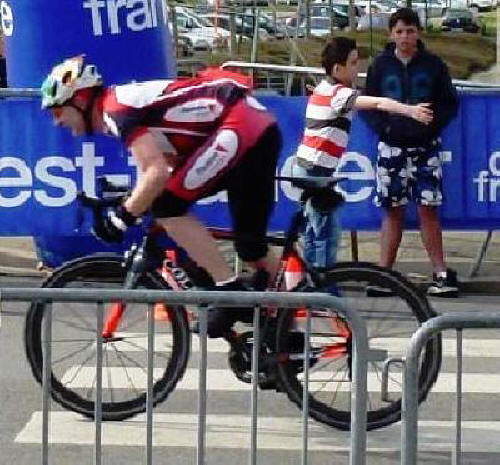
Sprinters ~ Enthralling
crowds around the world...
La Coulianise sprint ~ Le Mans
The romantics of the sport laude the trials and tribulations of the brave - slash - foolhardy escape artists of the day long breakaway. Plaudits constantly rain in for the gravity defying, artisan grimpeurs who fly to the heavens. But for me, there really is nothing quite like the manic adrenaline rush of a full-on, barging, jostling, snarling, testosterone-fuelled, Pamplona-fest, that is the bunch sprint.
For some, it's the final twenty seconds of a race that makes the previous hundred and fifty kilometres bearable. For others, it's time to hold back and keep out the way. Here's how you, if you can blank out the horrors of the reality, train to move from the latter to the former. The ability to sprint is within us all.
But I'm not a
Sprinter
Don't let anyone tell you that you can't sprint.
At the
pro level there are genetically gifted riders with an over abundance of
the glorious fast twitch muscle fibres that will always place them at
the front of any unfolding gallop; Cavendish, Greipel, Goss, Renshaw, etc.
But we're not pros, and that helps us in many ways. If you've made the selection, and are with the group at the end of a race, you're in with a chance of taking the line honours. All it takes is specific training, self-belief and a fear of losing that's greater than your perceived fear of sprinting.
If you have the fitness to be there, and have the bottle to get in the mix, you have the capacity to become a sprinter. All you have to do is carry out the correct training, at the correct time, apply the correct tactics and have a little luck. Never let anyone tell you you can't sprint. Trust me, you can.
In previous factsheets, we covered sprinting positioning, tactics and preparation. Here's how, when you're in a position to put those attributes in to practice, you can prepare to unleash hell...
Sprinting Dynamics
The twenty second explosion that separates
the winner from the rest of the field contains three main stages. The anatomy of a sprint consists of the launch, the surge and the
lunge.
It's the nuances of these three facets that can mean victory or disappointment. Only one person in the race gets to taste victory. Here's how you can maximise your chances of it being you.
 Before we start; handlebar grip position? Never, ever, ever, sprint, ever, with your hands on the hoods. Ever!
Before we start; handlebar grip position? Never, ever, ever, sprint, ever, with your hands on the hoods. Ever!
In the drops, always.
Picking teeth out of the tarmac (honestly, we've had to do it) is not a pleasant experience, especially when the rider is sitting at the side of the road, watching you prying his teeth out of the bitumen with a tyre lever.
Sprinting on the hoods is playing Russian Roulette with your dentist. You've been warned.
On that happy, motivational note, I bring you sprinting...
The Launch
Okay, we'll assume, you've found the right
wheel, you're out of the wind and sitting on someone's shoulder. You're in the right gear, at the right cadence, focussed, and mentally
ready to take the victory.
Often in a sprint I can hear all around me the unmistakable psh, psh, psh, of Continental shod, Zipp 404's skipping over the tarmac.
A sprint, by it's very nature, is an act of allegro. It should, however, be carried out with the adagio of Darcy Bussell. A sprint is nothing more than the brutal finesse of high-speed, balletic, jousting. And it all starts with your body position for "the launch".
It's an indisputable fact that a wheel can only propel the bike forward when it's in contact with the ground. A wheel in the air, has zero traction and zero forward motion.
Zero wheel traction means no resistance to push against. Therefore your cranks "skip" to the twelve o'clock, six o'clock position. Your legs now have no "circular momentum", so they lock up as the wheel hits the ground and a "metaphysical brake" is applied.
You're now trying to propel the bike forward from a "literal" standing start. And all this happened because your bum was in the wrong position.

jumping the pack in the far right gutter
Giro Lombardia Fondo ~ Lake Como
When it's time to sprint, you get out the saddle and your bum should come up and go backwards. Ninety-nine percent of riders shove themselves forward for the sprint to replicate the position of Usain Bolt coming out of the blocks. Yes, that's correct, but not yet!
Here's an SRM trace of one of our training sprints, undertaken in January 2012. I'll use this as our example of how it's done. We do these early ones uphill in a big gear, to get maximum resistance and neuromuscular power development. The orange line is the gradient, yellow is power, green is cadence, red is heartrate.
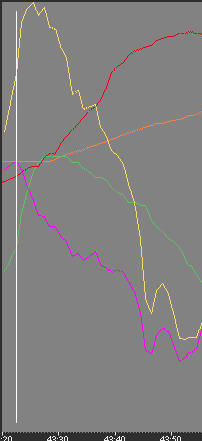
The initial launch phase of any sprint is when maximum torque is going through your drive train of choice, at probably the lowest cadence of the sprint sequence.
A lot is now about to happen in a very short space of time and it should, if your victory is to be achieved, happen instinctively.
You can see at the start of this training sprint the cadence is low, 70 rpm, the torque is at its maximum of 125 Newton-meters and the power is just under 800 watts.
Your bum needs to be behind the bottom bracket and ideally somewhere around the back third of the saddle.
You're pulling on the bars and pushing forward with your feet as though you are putting them in to your Timberland's.
Maximum torque demands maximum traction and you can only get that if your weight is keeping the back wheel firmly planted on the ground.
No skipping here, because ground lost here is rarely made up. For some, their sprint is lost in the first two seconds.
You should be second or third wheel at this point with 200 metres to go, out of the wind, with a clear sight of the line.
The launch is a delicate balancing act of forward propulsion and downwards application. It can be as little as six to eight pedal revolutions, but a perfect launch can steal you a vital meter in the race to the line. When a race is often won by centimetres, you begin to see the importance of this, "blink and you miss it" sprint preparation.
As I keep saying, it should be second nature. Once the spring arrives, practice this every time you go out on your bike.
The Surge
Okay, we're ten pedal revs and about two
seconds into our sprint, what next? As the initial launch phase completes, you now need to seamlessly move to the surge.
The
longest, and most painful, of the sprinting section. It seems like
it lasts forever, it doesn't. So concentration is key.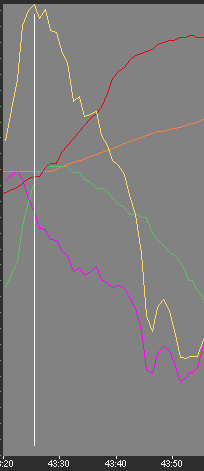
As we've got on top of the gear our cadence has picked up and our torque is dropping. As you all know, power is a product of torque multiplied by revs, so ironically, although it now feels easier, power has increased.
In this training session we're just about to hit the slope of the (orange) hill.
A few seconds after maximum torque and traction demands have dropped, we have maximum power output.
Once we've passed the max torque phase, our bum needs to come forward over the bottom bracket with the tip of the saddle just brushing the inner thigh.
It's at this point that we start generating maximum power. As you can see, this doesn't last very long. Two to four seconds at the most.
We now have 95 rpm, 110 N-m with 1025 watts and dropping.
As the power begins to drop you need to pull yourself forward so your bum is now well clear of the tip of the saddle and your pushing backwards like Usain Bolt out of the blocks. You now need to hold this for anything up to ten to twelve seconds.
You are now powered totally by your ATP-PC energy system, your willingness to suffer, and your will to win.
This is where it starts to really, really, really hurt and the legs begin to really, really, really burn. This is the longest section of the sprint but it doesn't have to be taken flat out!
You now need to get near to your maximal speed and present a minimal frontal area to the hidden hand of wind resistance that's holding you back. Your objective is to stay near the front, not to be on the front or to try and pull away from others. There's no use leading a 200 metre sprint for the first 190 metres!
The faster you go, the higher the wind resistance. The higher the resistance, the exponential the power requirements, and the pain, needed to overcome it. So don't go faster than you have to.
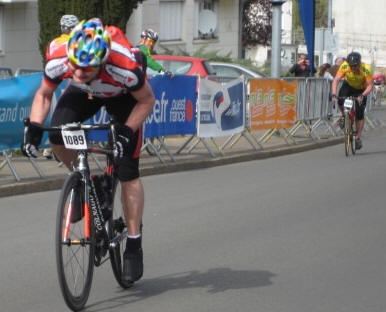
Even if you have a gap, never let up until the line, ever!
This is not contradictory to last sentence of the paragraph above!
Unlike the rider behind me, who's upright, on the hoods, with their head in the airstream. Keep your back flat, your elbows bent (and out to fend off or hold back protagonists), your head up and tilted to the side, your mouth open like a basking shark and your eyes fixated on the finish line, that's drawing you in.
And despite everything your body is telling you, keep those legs perpendicular and pumping...
The Lunge
Okay, we've launched, we've surged, but we're still not at the
line. What next?

Get aero ~ there's only one person winning this sprint
The middle part of the sprint (the surge) is to keep you at or near the front. It's the final lunge that takes you to the line, hopefully for the spoils of victory.
On the way to the line, you need to be totally aware of what's around and who's alongside you. If you need to look, look under your arms or between your legs. You don't deliberately block people, but you don't get out of their way either.
If someone's trying to come up your inside, just hold your line. Don't drift to the road centre and leave a gap underneath for some chancer to take a run at you. Be aware of where everyone is; no surprises.
As the surge phase progresses you need to move your bum forward and ahead of the bottom bracket as you can see in the picture at the top of the page. Keep it there and do not sit down!
We're now around 20 to 30 metres away from the line and you feel like there's nothing left. Well there is.
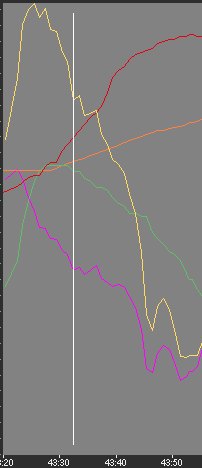
Although physically, your ATP-PC stores are depleted, so is everyone else's. The last 20 metres are down to willpower, hunger for the win and all your previous training and drills.
The micro efforts you saved during the surge, by not going too hard or flat out too soon, can now be reaped.
Take that stored kinetic energy and give one last push. The revs will rise (or at least stop dropping) the torque will increase and you get a little power spike for free. Just to the right of the white line.
This tiny rush of power gives you confidence to go again as all of a sudden you get back on top of the gear.
A second kick arrives (centre of the graph) that sends the bike forward just a few short centimetres. Sometimes, this is enough to break the will of those around you.
If they're still there, then finally comes the dénouement of the lunge, "the throw". If you've timed it right you should just be plateau-ing your speed two meters from the line.
If you're still accelerating, you went too late. If you're already being overtaken, you went too soon. Remember these "key performance indicators" and adjust accordingly for next time.
Just as you see the line, grip the bars, then throw the bike forward for all your worth. The final two metres go in the blink of an eye. Again, this is something you should practice on a weekly basis. Never, let yourself get beaten by a bike throw.
The only time you don't throw, is when you know there's no one within a bike length of you. It's now time to celebrate...
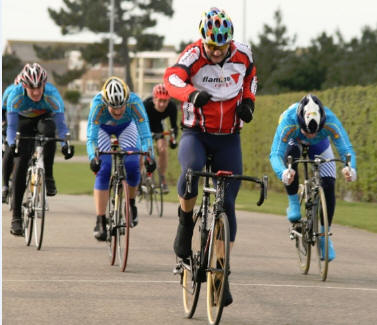
Bit of a lame
victory salute! Need to work on that...
But a good example of a throw on the right, for second!
Sprinting Drills and Sessions
If you're going to win sprints you need to
train for them. Don't think you can just get to the end of the
race and "go faster" in the hope of picking up the spoils.
If you're a flamme rouger, there's a fair chance you've done around sixty practice sprints before the first race of the season and (depending on your programme) around three to ten a week once the season's started. Practice, makes perfect.
First off, you need to build your neuromuscular power with some 30sec SMInts. Thirty second, Supra-Maximal Intervals. You go from a virtual standing start, in a big gear, and slowly wind it up for a maximum of 30 seconds. Uphill for out and out maximum power, on the flat for sustained power and lactate tolerance.
Here's an uphill one I did earlier. Right at the end you'll see my heart rate hit 202 bpm. It jumped sixty beats in thirty seconds. Maximal really means maximal...
Although there are a few drills you can do to increase your sprinting prowess, there is nothing like the real thing to bring on sustained improvement. So sprinting practice it is then.
During the late winter and early spring, we practice our sprint drills by coming down a gentle slope, to build up speed and save tweaking a muscle in the cold. From a medium speed we hit a steepening rise to create a resistance against our forward momentum. Here's a Strava profile of our practice slope...

This slope is the one used in the charts above and the video below. We're coming from left to right, we pick up speed on the way down, hit the base, then explode up the slope exiting stage right. Give it large for 10 seconds maximum, get to the "big tree" finish line, then relax. Here's how it looks in real life...
As you can see it's always good to practice with mates. This camera is on the bike of Island Games rider Ali Cann who's taking on (amongst others) UK Youth's pro sprinter Greg Mansell (who you see above and who dashes through the shot near the start of the sequence) and Ian Williams on his Kuota taking over the lead out from Mick Heald.
The others are made up of myself and a cast of flamme rouge ne'er do wells colloquially known as the Gregario's of the Gunsite Grupetto. To be honest, I've been called worse.
Ali's telemetry shows he's banging out an impressive 1483 watts, with a cadence of over 135 rpm, and topping out at over 36 mph, uphill, at the end of January! He even has time to back off ten metres before the line! (the big trees). Click here, to see the full screen video with music...
Greg, during the season, is now putting out over 1840 dizzying watts sprinting down Europe's finest boulevards. Ali is regularly taking the sprint spoils here in Jersey as he prepares for the qualification process for the next Island Games, to be held in Bermuda.
Your main objective, in a normal sprint, is to sustain the power output for as long as you can by stretching the yellow line, right, across the graph. These sprints are in January (when it's cold and damp) so the power drops off at a 45 degree angle. Come June and July it will drop off at a 33 degree angle. (Click the ATP-PC link above to see an example.)
More Speed
Once the season starts and you get a few
early sprints under your belt, you need to build your sprinting
capabilities from a very high speed. Most people can sprint from a
low to medium speed, it takes a special ability to be able to sprint
when you're going flat out!
The pro's, do this by sprinting from behind a scooter, an estate car with it's tailgate up, or a derny on the track. Riders like ourselves, mis-placed pro's, don't always have these facilities to hand. So what can we do to replicate it? Simple; turn the road around!
Once the season starts, come down the steep(er) side of the slope and sprint up the gentle side. If we come from the steep side and try to hit 50kph on the down bit, we can sprint up the gentle side with huge cadence and huge starting speed.
Once you've mastered that trick, you then sprint down the steep slope, where there's no resistance at all. You're now in your biggest gear (not all sprints are) with a 140 to 150 rpm and hitting very high speeds indeed. Which brings other performance and capability issues that need to be addressed.
To sprint fast you have to be comfortable with very high bike speeds and very high leg speeds, while keeping everything in balance and maintaining the "flow" of the manoeuvre. It's a lot harder than it looks.
Your bike will be moving around underneath you and you need to have the ability to be able to steer and guide your bike, but more importantly keep it straight and true, while it's "floating" over the tarmac. This is where the balletic movement comes in.
Finesse is everything in the finishing sprint. Dropping a shoulder just a centimetre or two can move your bike a metre across the road. At the most tense part of the whole event, everything must be relaxed, calm and in harmony. Hold the bars as you would a new born baby. Tight enough as to not let go but loose enough so as not to squash.
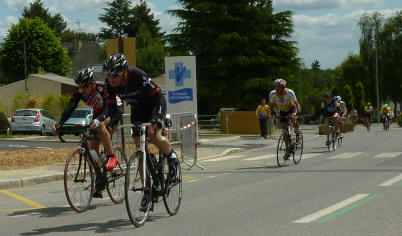
flamme
rougers Chris Stevens & Andrew Perree attacking the group and each other!
Marc Gomez Sportive ~ Chateaugiron
Something else you should practice and practice often. Go out with a friend, find a quiet road and practice sprinting and direction changes while riding at high speed. A race sprint isn't the first time you should experience brushing shoulders or bars with people!
But build up from a slow speed first. Don't fire off at 50 kph and start dropping your shoulder to see what happens!
Another Mis-Conception?
Many people go out and do a three hour ride,
then throw in a few practice sprints at the end. When I ask
"Why?", they say well that's when you sprint, at the end of a race.
Logical, but wrong!
If you've spent three hours working, riding around, doing your stuff, then try to do three sprints lets say you bang out an average 750 to 800 watts. Top effort well done. Nice numbers, but what are you going to do if it takes an average of 900 watts to win a sprint?
What if you did your sprint training in the first half-hour, after a good warm up? Now you're banging out over 1000 watts and are stressing all your energy systems, neural pathways and metabolic enzymes. Now you're building raw, race-winning, sprinting speed. Sprinting at 900 watts will be easy! Job done!
Always do your sprint training when you're fresh. Get it done, get it out of your system, then go and get your endurance in. An early sprint is a good sprint, it's a strong sprint, it's a winning sprint.
If you do, you could end up with a Mr and Mrs flamme rouge, Strava clean sweep! How good is this...? Although they'll probably be gone by tomorrow!
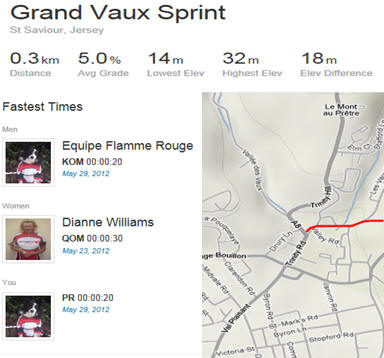
The Message
Sprints are violent, aggressive and
one of the most physically demanding aspects of our sport. When done right,
there's little on a bike that brings more pleasure or instant
gratification. Your lungs burst, your legs burn, your heart beats
through your chest, you feel so alive it's fantastic!
But the objective is to win as slowly as possible. If you go flat out too soon you may crash and burn. As you get a three metre lead, your legs fill with pain and you slow dramatically as the line approaches. Everyone comes around you. Game over.
Stay calm, stay aero, don't show your hand until you have to. Find out which three sections of the sprint suit you best and play to those advantages. Never let anyone else seize the initiative from you. When it's time to go, give it everything you've got.
You can rest after you've climbed down from the podium's top step.
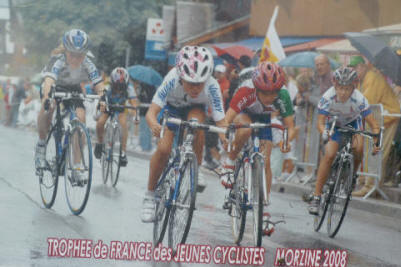
Here's another of my favourite photo's;
you're never too young to start
And here we are enthralling the crowds back in 1986...
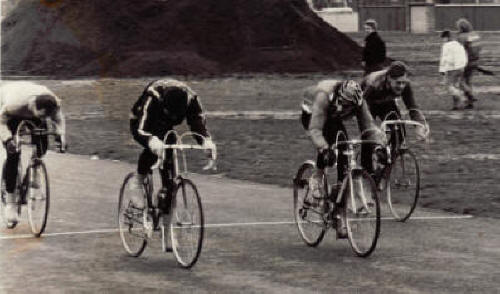
Me, Nick Smith (hoods!), the late, much missed Jayson
Lee and Martin Allix,
Pre-season sprint training (that's the start line, not the finish!).
Downshifters, big brake cables, six gears, toe clips, frame pumps, single bottle cages, wool jerseys and a leather "shammy". Steel bikes (Columbus SL and Reynolds 531c) and not a piece of carbon, a power meter or even a sniff of Di2 to be seen. You chose your gear 200 meters from before you started to sprint and stayed in it!
However, you might be able to see on my bars, that I had one of the first bike computer and heart rate monitors. It was the size of a kindle! Even back then, I was trying to find something to measure and distract me from my pain.
It's best feature? It would give your average speed so you could write it in your training diary to track progress!
Until next time...








